
 Everything You Should Know About Hair Dryers + Useful Resources And Guides
Everything You Should Know About Hair Dryers + Useful Resources And Guides
Hair dryers are important beauty tools every woman should have irrespective of their hair lengths. This is because they do not only help to dry your hair faster out of the shower but are also useful for styling hair.
A good hair dryer will also tame your tresses and leave them looking salon-styled from the comfort of your home irrespective of your hair type. Having said this, it is important to state here that hair dryers are not something that should be selected at random, – it should be carefully selected.
But how much do you know about this useful hair tool? In this article, we will be telling you everything you should know, this way, you will be well informed and guided on the things to look out for before settling for a good option.
History Of The Hair Dryer
In the earliest of time, people simply dried their hair under the sun and with the help of towels. Then as technology began to replace traditional methods, people became more creative.
Before the coming of hair dryers in the 1920s, women used vacuum cleaners to achieve the same purpose – they would simply connect the vacuum hose to the back end of the vacuum, turn it on and use the air from the vacuum to dry their hair.
Also See: Best Travel Hair Dryers – Don’t Trade Portability For Quality
This was what inspired the invention of the first ever hair dryer in history which was invented in the 19th century by a man called Alexander F. Godefroy solely for usage in his hair salon in France. His invention was not a portable or handheld type, it was a large, seated version that consisted of a bonnet that attached to the chimney pipe of a gas stove – It could only be used by having a person sit underneath.
With the coming of the first hair dryer (called bonnet or hooded dryer), women had to sit under it to have the hair dried. The hooded versions are still in use in many high-end salons around the world.
The handheld ones came much later, it first appeared on the market in 1925. They came with only 100 watts of heat and thus, were not able to dry hair quickly. They weighed over 2 lb (1 kg), this is because they were made of heavy steel and zinc.
Twenty-years down the line, engineers improved the design and managed to triple the heat output, raising it to 300 watts. By the 1960s, further improvements in electrical technology allowed the production of hair dryers with up to 500 watts of power.
Another aspect of the styling tool that manufacturers have had to improve over the years is the area of its safety. Early hair dryers were really dangerous – If they accidentally came in contact with water they would short circuit and cause an electrical shock.
There are hundreds of recorded cases of accidental electrocutions because a hairdryer was dropped into a bathtub or sink full of water while it was being used, so in the late 1970s, the Consumer Products Safety Commission (CPSC) recommended guidelines for hair dryer manufacturers to follow that would create safer products.
The power of hair dryers was then limited by the electric motors available. As smaller, more efficient motors were developed, greater airflow and greater heat output were achieved. By the 1990s portable hair dryers could produce over 1500 watts of heat.
Improvements in plastic technology and the discovery of new insulating materials made possible a new generation of lightweight hairdryers. Modern hair dryers can produce up 2000 watts of heat and can dry hair faster than ever before.
Types Of Modern Hair Dryers

With advancement in technology, you will hear names such as tourmaline, ionic, Titanium, ceramic, when modern hair dryers are being mentioned and it is important to understand what they mean so as to find something that best matches your hair type for better results.
Tourmaline: Tourmaline hair dryers are made from a semiprecious gemstone called tourmaline. This stone comes in several unimaginable colors and generates a lot of negative ions at once when it’s exposed to heat, producing even more negative ions than normal ionic dryers mean quicker drying and less heat damage. The negative ions in ionic hair dryers actually soften and smooth hair, reducing frizz and static.
Ionic: Ionic hair dryers neutralize positive charges in hair because they generate negative ions. The molecules of water on your hair are positively charged so when the negative ions hit, it breaks down any water molecules in your hair, thus, creating a faster drying period.
Ceramic: Hair dryers made from ceramic have much more even and gentle heating mechanism than other dryers. They contain self-regulating heaters and motors that are constructed of ceramic coils which emit infrared heat waves that dry your hair fast without cooking it into a straw – this is probably why stylist love it. Ceramic hair dryers are great for people with fine or heat damaged hair.
Titanium: Titanium is a very lightweight metal that significantly reduces the overall weight of the dryer. Titanium dryers run hotter than other hair dryer materials.
Basic Components Of The Hair Dryer
In producing hair dryers, there are several components required but the two most important ones are the heating element and the fan. These two are so important because they are the powerhouse.
Heating element: The heating element of a hair dryer is made of a metal coil or ceramic ion technology which helps protect hair from dry heat and overdrying. What the heating element actually does is to take the electric energy provided by the electrical outlet, and as it heats, it turns this energy into convective energy (instead of electricity).
Fan: The fan driven by a small motor inside the hair dryer, which is powered by electricity from the outlet propels the convective heat out of the dryer to your hair. The air from the fan passes over the heating element, blowing the heat from the coil to your wet hair.
Buying The Best Hair Dryers – Things To Look Out For
Choosing a hair dryer can be less difficult if you know exactly what to look out for. You could try putting these things into consideration the next time you go shopping for a hair dryer.
Hair Type: Since hair texture differs from person to person, a hair dryer must have the necessary features to address those hair needs. So in choosing hair dryers, be sure it is one that is perfect for your hair type.
Check Out The Wattage: A high-wattage motor packs mean more wind power and less styling time without exposure to excessive heat. According to hair celebrity hairstylist Kristin Ess: “If the motor isn’t strong, you end up with more heat and less wind—if you think about it, that means you’re ‘toasting’ your hair dry.” So while shopping for hair dryer look for a wattage of 1800 to 2000, especially If you have extremely thick, difficult to dry hair.
Heat And Air Flow Settings: Before settling for a hair dryer, be sure to consider one with multiple heats and air flow setting, this is because separate settings for heat and airspeed will give you more control. while the highest setting is best for removing the moisture from your hair, the lower setting is best used for styling.
Size is Important: Go for something portable and less bulky if you are getting the dryer for personal use. This will allow for better control as you dry and style your hair and also makes it easy to store. Portable hair dryers can also serve as travel dryers.
Don’t Forget The Diffuser/Volumiser: A diffuser is an attachment that distributes the hot air in a larger area without blowing your hair all over the place. This works perfectly if you have curly or wavy hair because it helps keep the texture intact while still adding volume.
Diffusers with longer fingers – sometimes called volumizers – are designed to add volume to all types of hair by directing heat to the roots.
Switches: Ensure the switches are accessible, easy to operate and well-labeled.
Cool Shot: This is another important feature to look out if you will be getting a new hair dryer, especially, if you will be using it for styling purposes. Most standard hair dryers will have a Cool Shot button on the handle. When you press it, cool air will be released.
Taking Care Of Your Hair Dryer (Useful Guides)
This is really not an option – if you really want your hair dryer to last longer and also give you the best results, you have to take care of it in several different ways. Asides keeping it away from water, you also have to learn to clean it from time to time and to do this, you need guidelines because of the delicate nature of the product.
Cleaning Hair Dryer Filter
Your hair dryer filter is something you have to check from time to time to know when it is due for cleaning. Wondering what it is? Well, the filter is that part of the dryer that serves as a protective layer that catches dust and debris to keep the motor clean.
If the filter is clogged, the motor can overheat, which is not only bad for your hair dryer but can be very dangerous. So as soon as you notice any build-up, the wise thing is to just clean the filter and cleaning it is just as easy as unscrewing the cover, popping out the filter, and with a small brush, clean toothbrush, or damp cloth remove all the buildup from the vent and allow to air dry before use.
Cleaning Hair Dryer Attachments
It is important to clean hair dryer attachments like the nozzles and diffusers for efficient results. To clean the attachments, rinse with warm, soapy water. Allow to soak if there is a lot of hair product build-up on the attachments. Once they are rinsed, let them air dry before use.
Most dryers also come with warranties, so be sure to register or save them in case you need to return or replace your purchase.
Also See: Best Blackhead Remover – Masks and Tools that Work All the Time
Safety Tips For Using Hair Dryer
Hair dryers are one of the most common household items associated with electric shock so it is important that we’re using them safely to prevent injury to ourselves and others.
- Make sure your hair dryer is in good working order.
- Don’t use it if the power cord is damaged.
- Avoid using your hair dryer in wet areas.
- If water comes in contact with your hair dryer, turn it off and unplug it immediately.
- When disconnecting your hair dryer, turn it off first at the switch before pulling out the plug.
- Ensure the power cord is not dangling from benches or within your child’s reach.





